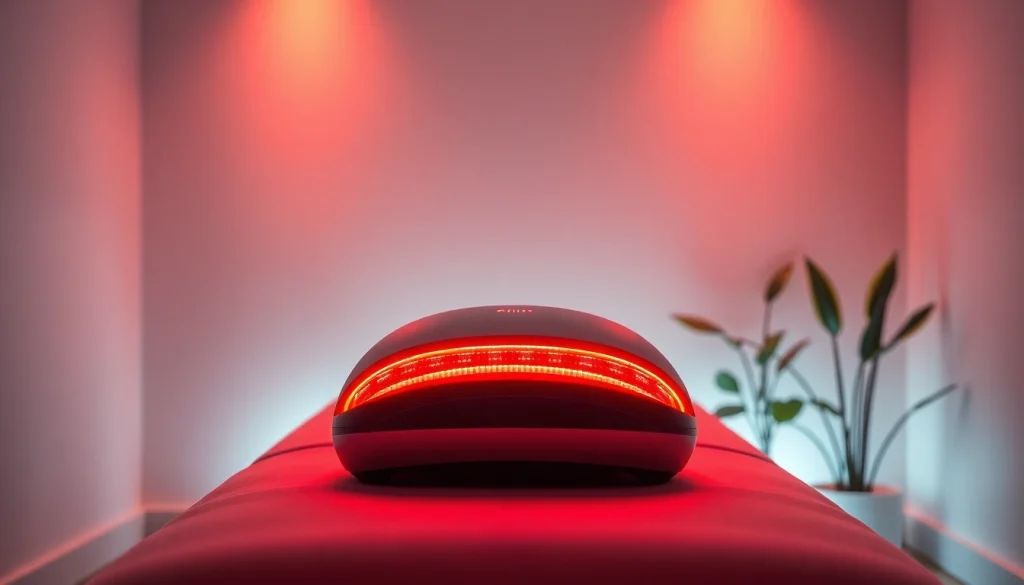Understanding Red Light Therapy and Its Benefits
In recent years, red light therapy at homeull body has emerged as an innovative approach to enhance wellness and treat various ailments. This technology employs specific wavelengths of red light to stimulate healing processes within the body. With an increasing focus on wellness, understanding red light therapy can provide insights into its benefits and potential uses at home.
The Science Behind Red Light Therapy
Red light therapy (RLT) utilizes low-level wavelengths of red light to penetrate the skin and impact cellular functions. By targeting mitochondria— the powerhouse of the cell—RLT enhances ATP production, resulting in increased energy for cells. Studies suggest that this increase in cellular energy can promote healing and reduce inflammation, making it a valuable tool for managing pain and skin conditions.
The key wavelengths typically used in red light therapy range from 600 to 1000 nanometers. At these wavelengths, light can penetrate deep into the skin, triggering a series of biochemical events. These events include increased blood flow, enhanced immune responses, and improved collagen synthesis, contributing to overall skin health and tissue repair.
Benefits of Red Light Therapy for Skin and Pain Management
The benefits of RLT are extensive, particularly for skin health and pain management. For skin conditions, studies have shown that red light therapy can effectively treat acne, psoriasis, and signs of aging such as wrinkles and fine lines. The therapy promotes collagen production, improving skin elasticity and texture.
When it comes to pain management, RLT can offer substantial relief. Clinical studies have demonstrated its effectiveness in reducing inflammation and pain associated with arthritis, joint issues, and muscle soreness. By promoting better circulation and healing, patients have reported significant improvements in mobility and comfort after RLT sessions.
How Red Light Therapy Works for Overall Health
Beyond skin and muscular benefits, red light therapy offers potential advantages for overall health. Research indicates that it can aid in reducing symptoms of anxiety and depression, likely due to its role in enhancing mitochondrial function and promoting a healthy stress response.
Furthermore, RLT has shown promise in enhancing recovery from workouts by reducing muscle fatigue and soreness. Athletes increasingly use this therapy to speed up recovery times and improve performance, helping them train effectively and maintain peak physical condition.
Choosing the Right Red Light Therapy Device for Home
With the growing popularity of red light therapy, various devices are available for home use. However, selecting the right one depends on several factors and individual needs. Understanding the types of devices and how to evaluate them will help you make an informed decision.
Types of Red Light Therapy Devices
Red light therapy devices come in multiple forms, including handheld units, LED panels, and full-body light beds. Each has unique features designed for specific applications:
- Handheld Devices: Generally portable and easy to use, these are ideal for targeting specific areas, such as the face or localized pain regions.
- LED Panels: Larger panels can cover more surface area, making them suitable for treating broader areas of the body, such as the back or legs.
- Full-Body Light Beds: These provide comprehensive exposure, making them an effective option for individuals seeking full-body therapy.
Factors to Consider When Purchasing
When choosing a red light therapy device, consider the following factors:
- Wavelength: Ensure the device operates within the therapeutic ranges of 600-1000 nm for maximum efficacy.
- Power Output: Look for devices with adequate power output (measured in watts) to ensure effective penetration of light.
- Size and Portability: Depending on your needs, select a device that fits your space and lifestyle. Compact devices may be suitable for home use, while larger systems would require designated areas.
- Device Reviews: Research customer feedback and clinical evidence to determine the device’s reliability and effectiveness.
Top Features to Look For
As you evaluate potential devices, remember to look for features that enhance usability:
- Timer Settings: Integrated timers allow users to customize treatment durations, which is essential for proper therapy sessions.
- Adjustable Settings: Devices with adjustable wavelengths or intensity settings can offer more personalized care.
- User-Friendly Design: Ergonomic designs and clear displays can enhance usability and ensure a smooth experience during use.
Best Practices for Using Red Light Therapy at Home
To maximize the benefits of red light therapy, adopting best practices for usage at home is crucial. Knowledge about setup, treatment frequency, and safety can vastly improve the effectiveness of RLT.
How to Set Up Your Therapy Space
Your therapy space should be relaxing and conducive to the treatment. Choose a calm environment with minimal distractions, and set the device at an appropriate distance based on the manufacturer’s recommendations—typically between 6 to 24 inches from the skin surface. Aim to create a space that allows you to sit or lie comfortably during treatment.
Optimal Treatment Frequency and Duration
Your treatment frequency will depend on your individual goals and the device’s instructions. Generally, it is recommended to start with sessions ranging from 10 to 20 minutes, several times a week. As your body responds, you can adjust the frequency and duration based on how you feel and your specific needs. Always listen to your body and consult user guidelines for the best practices.
Safety Precautions and Guidelines
While red light therapy is generally safe, adhering to safety guidelines is essential to avoid potential pitfalls. Always wear protective eyewear if your device emits bright light, and avoid exposing your skin to direct sunlight immediately after treatment to prevent burns. Furthermore, consult a healthcare professional if you have sensitive skin or underlying health conditions before starting therapy.
Exploring Research and Evidence Supporting Home Use
A critical aspect of understanding red light therapy lies in examining the research and evidence that support its efficacy for home use, encompassing clinical studies, testimonials, and professional endorsements.
Review of Clinical Studies on Red Light Therapy
Numerous clinical studies validate the effectiveness of red light therapy across various applications. Research on its use in wound healing, muscle recovery, and dermatological conditions has produced consistent findings supporting its therapeutic potential. Comprehensive meta-analyses conclude that RLT can significantly improve healing time and relieve inflammation, offering a non-invasive alternative to traditional treatments.
Personal Testimonials and Success Stories
Many individuals have embraced red light therapy as part of their holistic health strategies. Testimonials reveal substantial improvements in conditions ranging from chronic pain and joint issues to skin rejuvenation. Personal success stories underline the transformative effects RLT can have on quality of life, reinforcing the value of this innovative treatment.
Regulatory Approvals and Device Efficacy
The rise of red light therapy devices has also prompted regulatory bodies to evaluate their efficacy. Many devices are now FDA-cleared for specific treatments, offering assurances regarding their safety and effectiveness. This regulatory endorsement supports trust in the technology, encouraging more widespread acceptance and utilization.
Integrating Red Light Therapy into Your Wellness Routine
Incorporating red light therapy into your daily wellness routine can lead to substantial improvements in overall health. Employ strategic combinations with other treatments and closely monitor your journey for optimal results.
Combining Red Light Therapy with Other Treatments
Following a comprehensive wellness plan often involves integrating various therapeutic modalities. Red light therapy can complement other treatments like physical therapy, massage, and skincare regimens, enhancing overall effectiveness. Discussing your approach with a healthcare provider may yield tailored recommendations for the best synergistic effects.
Monitoring Your Progress and Results
Documenting your experiences with red light therapy is vital for measuring success and determining necessary adjustments. Keep a log detailing treatment durations, symptom improvements, or any side effects. Engaging in this practice fosters accountability and empowers you to optimize your routine effectively.
Long-Term Health Benefits of Regular Use
Consistent engagement with red light therapy could yield lasting health benefits. Regular use can improve skin health, reduce chronic pain, and enhance general wellness. By prioritizing red light therapy within your lifestyle, you may experience cumulative benefits that contribute significantly to a sustained sense of wellbeing.


